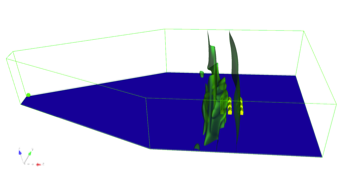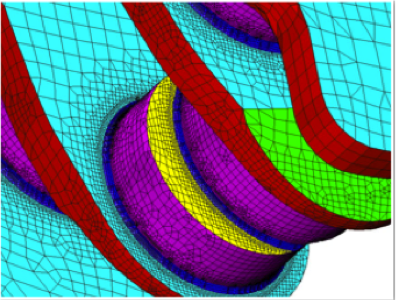The rigid body dynamics solver provides:

The compressible flow solver uses a locally-conservative DG/FVM formulation.

Export Control
Computational Sciences International, LLC is based in the United States of America and all products are developed in the U.S or via online collaboration in public forums and distributed from within the U.S. As a result, U.S. export laws and regulations apply to the distribution of Computational Sciences International products, and remain in force as products and technology are re-exported to different parties and places around the world.
IF YOU EXPORT COMPUTATIONAL SCIENCES INTERNATIONAL PRODUCTS, YOU ARE RESPONSIBLE FOR COMPLYING WITH THE REQUIREMENTS OF THE BUREAU OF INDUSTRY AND SECURITY ("BIS"), EXPORT ADMINISTRATION REGULATIONS ("EAR"), OR OTHER U.S. EXPORT LAWS.
Classifcation Matrix
The Computational Sciences International Product and Services Classification Matrix ("Matrix") is a general listing of Computational
Sciences International software products and services. The matrix is to be used in conjunction with the Export Administration Regulations ("EAR") in order to assist our customers in the export of Computational Sciences International products. All classification information contained in the matrix is subject to change without notice.
The Matrix is not intended to replace the EAR and other U.S. Export laws, but is provided as an accommodation to our customers to be used in conjunction with said laws to assist in the export of Computational Sciences International products and services. The exporter is responsible for exporting Computational Sciences International products, in accordance with the requirements of the EAR and other U.S. Export laws. End-user, end-use and country of ultimate destination may affect export licensing requirements. All Export Control Classification Numbers ("ECCN"), HTS Numbers and License Authorization information are subject to change without
notice. Modification in any way to a Computational Sciences International product voids the classification. It is your obligation as an exporter to verify such information and comply with the current applicable regulations.
Computational Sciences International makes no warranty or representation that the information contained on this site is
accurate, current, or complete. It is your obligation as the exporter to comply with the current applicable requirements of United States export rules and regulations. Any use of such information by you is without recourse to Computational Sciences International and is at your own risk. Computational Sciences International is in no way responsible for any damages whether direct, consequential, incidental, or otherwise, suffered by you as a result of using or relying upon such information for any purpose.
Product and Services Classification Matrix
| Product Name* |
ECCN | LIC (Exception) |
| Hydra Toolkit | N/A1 | Not Subject to EAR2 |
*IF YOU EXPORT COMPUTATIONAL SCIENCES INTERNATIONAL PRODUCTS, YOU ARE RESPONSIBLE FOR COMPLYING WITH THE REQUIREMENTS OF THE BUREAU OF INDUSTRY AND SECURITY ("BIS"), EXPORT ADMINISTRATION REGULATIONS ("EAR"), OR OTHER U.S. EXPORT LAWS.
1Not Applicable
2Section 734.7
Hydra is an extensible C++ toolkit that provides a rich suite of components for rapid application development, supports multiple discretization techniques, provides I/O interfaces to permit reading/writing multiple file formats for meshes, plot data, time-history, surface-based and restart output. Data registration is used to provide the ability to register variables at appropriate locations (e.g., node, element, dual-edge, etc), and provides integrated and automatic output and restart capabilities along with memory management. The toolkit also provides run-time parallel domain decomposition with data-migration for both static and dynamic load-balancing. Linear algebra is handled through an abstract virtual interface that makes it possible to use popular libraries such as PETSc and Trilinos. The use of output delegates provides the ability to develop lightweight physics-specific output kernels with minimal memory overhead that can be tailored to a specific physics, e.g., computation of vorticity, helicity, enstrophy for large-eddy simulations. A flexible material model interface supports a broad collection of material properties that include non-Newtonian viscosities, material strength models, and equations of state.
Hydra's toolkit model for development provides lightweight, high performance and reusable code components for agile development. The Hydra toolkit has been used for methods and algorithms research with a broad array of physics, discretization techniques and solution methods. Currently the toolkit supports finite-element based solvers for time-dependent heat conduction, time-dependent advection-diffusion, time-dependent incompressible flow, multiple Lagrangian hydrodynamics solvers, rigid-body dynamics, etc. In addition, unstructured-grid finite-volume solvers are available for solving time-dependent advection-diffusion, Burgers' equation, the compressible Euler equations, and the hybrid incompressible/low-Mach Navier-Stokes equations, and for multiphase flow.
The following list outlines the design principles, physics,discretization and overall Hydra Toolkit capabilities.
Design Principles
- Parallel and scalable by design
- Interface centric, component based
- C++ w. edge-based data structures for finite volume methods
- ~106 elements in 2 GByte memory
- Parallel: 10s to O(10,000) cores
- Grid sizes: 106 to 109 elements
- Extensible for advanced architectures
Physics & Discretizations
- Heat conduction
- Advection-diffusion
- Burger's equation
- Incompressible fluid flow
- Compressible fluid flow
- Eulerian multiphase flow
- Rigid-body dynamics
- Variational multiscale hydro
- FEM single/multimaterial hydro
- Cell-centered FVM hydro
- Interfaces for level-sets and front-tracking (FronTier)
Multiphysics Interfaces
- Fluid-Structure Interaction
- Conjugate Heat Transfer
Linear Algebra Interface
- Abstract interface for native, third-party, and commercial solvers
- Advanced Preconditioners
- Native: CG, FGMRES
- PETSc: CG, GMRES, FGMRES, algebraic multigrid, ILU preconditioners
- Trilinos: **NEED TO FILL THIS OUT**
- Nvidia: GPU-based algebraic multigrid
Load Balancing
- Abstract interface for run-time parallel load balancing
- Static and dynamic load balancers
- Graph and spatial decomposition algorithms
Material Model Interface
- Newtonian/Non-Newtonian Viscosities: Carreau-Yasuda, Cross, Ellis-Meter, Herschel-Bulkley, Powell-Eyring
- Porous Media: Carman-Kozeny permeability
- Temperature dependent thermal properties (conductivity, specific heat, etc.)
- Material strength: elastic-plastic, Johnson-Cook, Prandtl-Reuss
- Ideal-gas equation of state
- Abstract extensible interfaces for easily adding material properties
Turbulence Models
- ILES
- WALE
- Smagorinsky
- Spalart-Allmaras
- DES/Spalart-Allmaras
- RNG k-epsilon
Boundary Conditions
- Set-based description of all boundary conditions
- Physics-specific prescription of common Dirichlet and Neumann conditions
- Specialized boundary conditions for fluid flow, Lagrangian dynamics
Element Library 
- 2-D Quadrilateral
- 2-D Arbitrary Polygon
- 2-D Triangle
- 3-D Hexahedron
- 3-D Pyramid
- 3-D Wedge
- 3-D Arbitrary Polyhedron
Input Formats
- ASCII Keyword Input
- ASCII Neutral Format Mesh
- Exodus-II/HDF5 Mesh
- Abstract interface for mesh readers permitting easy addition of additional file formats
Output Formats
- Output includes multiple files for visualization that include field and time-history data at varying time intervals.
- ASCII Time-History
- Exodus-II/HDF5 for plot and statistics data
- ASCII VTK for plot and statistics data
- Abstract interface for output writers permitting easy addition of additional file formats
Mesh Generators
- Compatible with a large number of mesh generation tools
- Numeca Hexpress/Hybrid
- Cubit
- Trelis
- TrueGrid
- ICEM CFD
- GridGen
Visualization Tools
- Compatible with a large number of visualization tools
- Ensight
- ParaView
- VisIt
- MATLAB
- Octave
- Grace
- GNUplot
Supported Platforms
- MacOs
- Linux desktop, clusters
- DOE Supercomputers: TITAN, LANL Clusters


